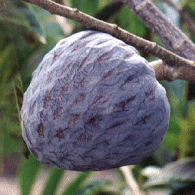


IMPORTANT: The information provided is for information only. The medical claims or advice are not endorsed. Never take any medicines without first consulting a qualified practitioner.

When fully ripe, the fruit has soft custardy flesh, which is eaten scooped from the skin, or served with light cream and a sprinkling of sugar. Often it's pressed through a sieve and added to milkshakes, custards or icecream. Its flavour is sweet although not as distinctive as the related cherimoya or sugar apple.
The seeds, leaves and young fruits are used in insecticides, and the leaf juice is said to kill lice.
The fruit's hard seeds should never be chewed, as the kernel is very toxic. However, swallowing them whole by accident probably won't harm you. Sap oozing from cut branches is an irritant and can severely injure the eyes.

The leaves have been used in tanning and yield a blue or black dye.
Some medicinal uses recorded in Sloane's journal are known in South America. For example, crushed leaves or a paste of the flesh are used as a poultice on boils, abscesses and ulcers.
The dried and powdered unripe fruit is rich in tannin and is used against diarrhoea and worms, as is a drink made from the bark. In severe cases, leaves, bark and green fruits are all boiled together in water to make a very potent brew.
Fragments of the root bark are packed around the gums to relieve toothache. A decoction of the root is taken to bring down fevers.
The fruit can have a distinctive heart shape and darken to reddish brown when ripe, which explains one of its common names, bullock's heart.